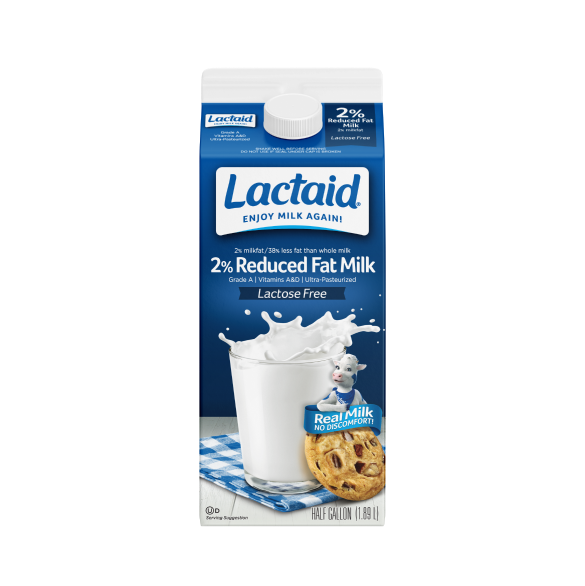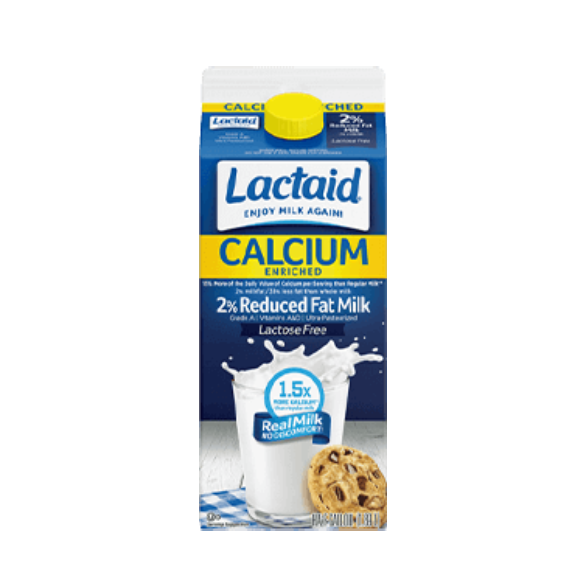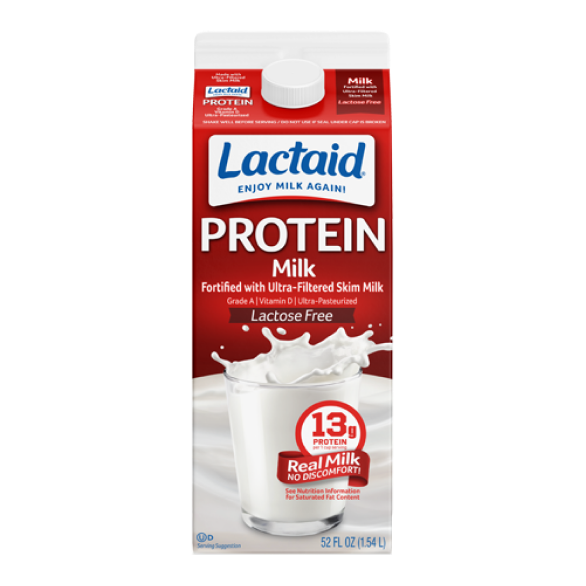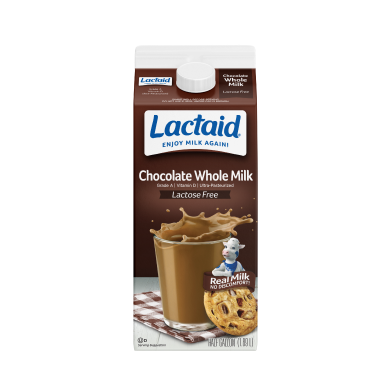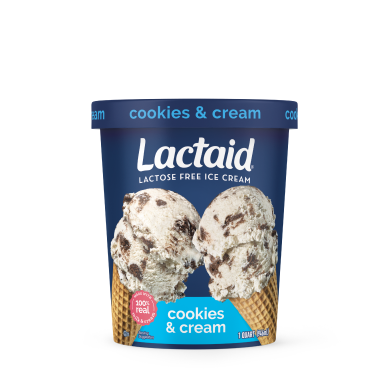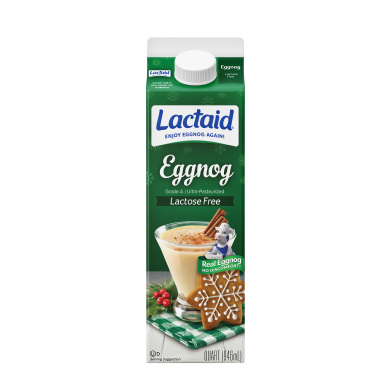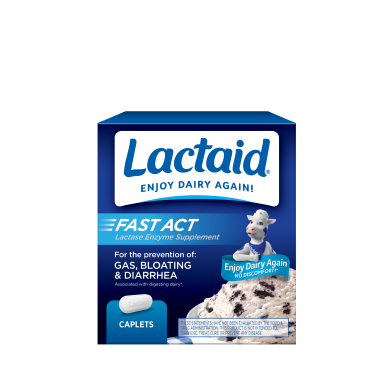What Is Lactose Intolerance and Lactose Sensitivity?
Did you know that dairy foods contain a sugar called lactose? Our bodies produce an enzyme called lactase, which breaks down the lactose sugar found in dairy and milk. Unfortunately, some of us have less lactase in our bodies, potentially causing you to experience gas, bloating, cramps, or diarrhea after you eat foods containing lactose, like milk.
Having less lactase enzymes and experiencing discomfort after eating high-in-lactose foods, like milk and cheese, is lactose intolerance. Since our discomfort to dairy and lactose varies based on our bodies, people have varying degrees of lactose intolerance, or lactose sensitivity.
Is Lactose Causing Your Sensitivity to Dairy?
Performing an at-home lactose intolerance test can help you find out if your sensitivity to dairy is caused by a sensitivity to lactose. All you have to do is eat! (Okay and track any discomfort you may feel.) If you aren't sure how your digestive system will react to dairy, you should take the test at a time that you'll mostly be home. If the evaluation indicates you may be sensitive to lactose, you should talk to your doctor who can help diagnose your condition.
Nota: Lactose intolerance and sensitivity is very different than having a dairy allergy. If you have a dairy allergy, a condition where your immune system does not recognize one or more of the proteins in dairy products, this test is not intended for you and you should not continue with testing a lactose sensitivity.
Lactose Sensitivity Test Checklist
Use this simple checklist to track your discomfort during the lactose sensitivity test as outlined in the instructions below. If you experience any of these symptoms, circle the number indicating its intensity. Discomfort associated with lactose sensitivity and intolerance is typically experienced 30 minutes to two hours after eating dairy with lactose in it.
Day 1 Checklist
SYMPTOMS: |
NONEMILDSEVERE |
||||
|---|---|---|---|---|---|
Gases |
1 |
2 |
3 |
4 |
5 |
Inflamación |
1 |
2 |
3 |
4 |
5 |
Cramping |
1 |
2 |
3 |
4 |
5 |
Diarrea |
1 |
2 |
3 |
4 |
5 |
Day 2 Checklist
SYMPTOMS: |
NONEMILDSEVERE |
||||
|---|---|---|---|---|---|
Gases |
1 |
2 |
3 |
4 |
5 |
Inflamación |
1 |
2 |
3 |
4 |
5 |
Cramping |
1 |
2 |
3 |
4 |
5 |
Diarrea |
1 |
2 |
3 |
4 |
5 |
Lactose Intolerance Test Instructions
Day Before Test
Don't eat anything after 10 PM on the night before the test.
Day 1
-
Enjoy a dairy-free breakfast, such as eggs and whole wheat toast and jam. It’s important to avoid any foods that contain dairy during this meal, including yogurt or cheese. You can find a list of foods that contain dairy at the bottom of this page. In addition to your meal, drink a large 12 fl. oz. glass of fat free regular milk.
-
Over the next 3 hours after drinking the glass of milk, keep track of any discomfort you experience (gas, bloating, cramping, diarrhea) and its intensity using the Day 1 test checklist above. Circle the number indicating the intensity of each symptom. Do not eat anything else during this time. Discomfort from a lactose sensitivity is typically felt 30 minutes to two hours after eating dairy.
Nota: If you experience any unusual stomach discomfort beyond the typical symptoms you normally experience after eating dairy, speak with a doctor immediately. -
After the 3-hour testing period, feel free to eat lunch and dinner as usual, but do not eat or drink anything after 10 PM.
Day 2
-
Enjoy the same breakfast as Day 1, except replace the fat free regular milk with a large 12 fl. oz. glass of LACTAID® Fat Free Milk.
-
Keep track of any discomfort you experience (gas, bloating, cramping, diarrhea) and its intensity over the next three hours using the Day 2 test checklist above. Circle the number indicating the intensity of each symptom. Discomfort from a lactose sensitivity is typically felt 30 minutes to two hours after eating dairy. Do not eat anything during this time.
Nota: If you experience any unusual stomach discomfort beyond the typical symptoms you normally experience after eating dairy, speak with a doctor immediately. -
After the 3-hour testing period, feel free to eat the rest of your meals as usual.
Assessing Your Lactose Sensitivity Test Results
How did you feel on Day 2 compared to Day 1 of the test? If your stomach was upset on Day 1, but not on Day 2, or if the symptoms were milder than on Day 1, you may have a sensitivity to lactose and may be lactose intolerant. To determine this, we recommend talking with your doctor. If you have a lactose sensitivity, LACTAID® Products can help you eat dairy again without the discomfort. Learn more about living with lactose intolerance.
It’s Important to Consult with Your Doctor
The lactose intolerance test outlined here is simply a self-test. While this test can help you understand if you might have lactose intolerance, you should speak with a doctor to receive an official diagnosis.
To learn more about your symptoms related to dairy consumption and what they might mean, try taking our Lactose Intolerance Quiz.
List of Common Dairy Food and Beverages that Contain Lactose
COMIDAS Y BEBIDAS |
PORCIÓN |
LACTOSE (GRAMS) |
|---|---|---|
|
Leche: whole, low-fat, skim |
1 taza |
12 |
|
Buttermilk |
1 taza |
12 |
|
Goat milk |
1 taza |
11 |
|
Fat free dry milk |
⅓ cup |
12 |
|
Half and half |
2 cucharadas |
Cantidades ínfimas |
|
Light cream |
2 cucharadas |
Cantidades ínfimas |
|
Whipped cream |
2 cucharadas |
Cantidades ínfimas |
|
Crema agria |
2 cucharadas |
1 |
|
Condensed milk, whole |
2 cucharadas |
4 |
|
Evaporated milk |
2 cucharadas |
3 |
|
Butter, margarine |
1 tablespoon |
Cantidades ínfimas |
|
Yogurt, low-fat |
1 taza |
5 - 12 |
|
Queso cottage |
½ taza |
3 - 5 |
|
Helado |
½ taza |
6 - 9 |
|
Sherbert |
½ taza |
2 |
|
Queso: american |
1 rebanada |
1 - 2 |
|
Queso: cheddar, swiss |
1 ounce |
1 - 2 |
|
Cream cheese |
1 ounce |
1 |
COMIDAS Y BEBIDAS |
LACTOSE (GRAMS) |
|---|---|
|
Leche: whole, low-fat, skim SERVING1 cup |
12 |
|
Buttermilk SERVING1 cup |
12 |
|
Goat milk SERVING1 cup |
11 |
|
Fat free dry milk SERVING⅓ cup |
12 |
|
Half and half SERVING 2 tablespoons |
Cantidades ínfimas |
|
Light cream SERVING 2 tablespoons |
Cantidades ínfimas |
|
Whipped cream SERVING 2 tablespoons |
Cantidades ínfimas |
|
Crema agria SERVING 2 tablespoons |
1 |
|
Condensed milk, whole SERVING 2 tablespoons |
4 |
|
Evaporated milk SERVING 2 tablespoons |
3 |
|
Butter, margarine SERVING 1 tablespoon |
Cantidades ínfimas |
|
Yogurt, low-fat SERVING1 cup |
5 - 12 |
|
Queso cottage SERVING½ cup |
3 - 5 |
|
Helado SERVING½ cup |
6 - 9 |
|
Sherbert SERVING½ cup |
2 |
|
Queso: american SERVING1 slice |
1 - 2 |
|
Queso: cheddar, swiss SERVING1 ounce |
1 - 2 |
|
Cream cheese SERVING1 ounce |
1 |
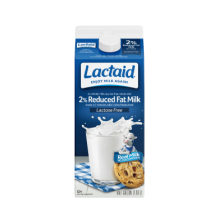
Leche sin lactosa LACTAID® reducida en grasa al 2 %
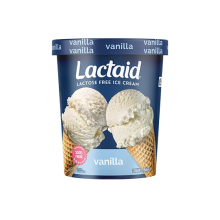
Helado sin lactosa de vainilla LACTAID®
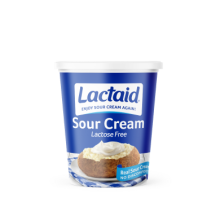
Crema agria sin lactosa LACTAID®


¿Eres intolerante a la lactosa?
Responde algunas preguntas para ver si tus síntomas pueden ser debido a la intolerancia a la lactosa o a una alergia a la leche.
HAZ EL EXAMEN








